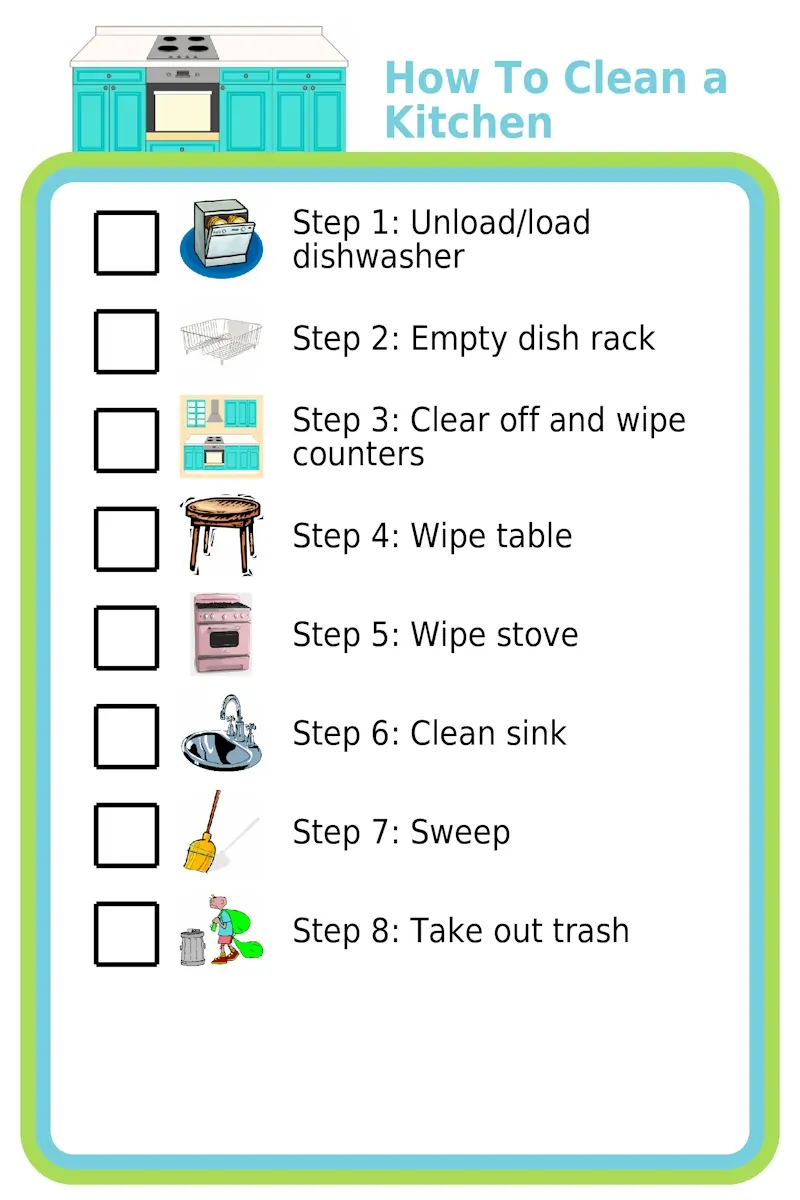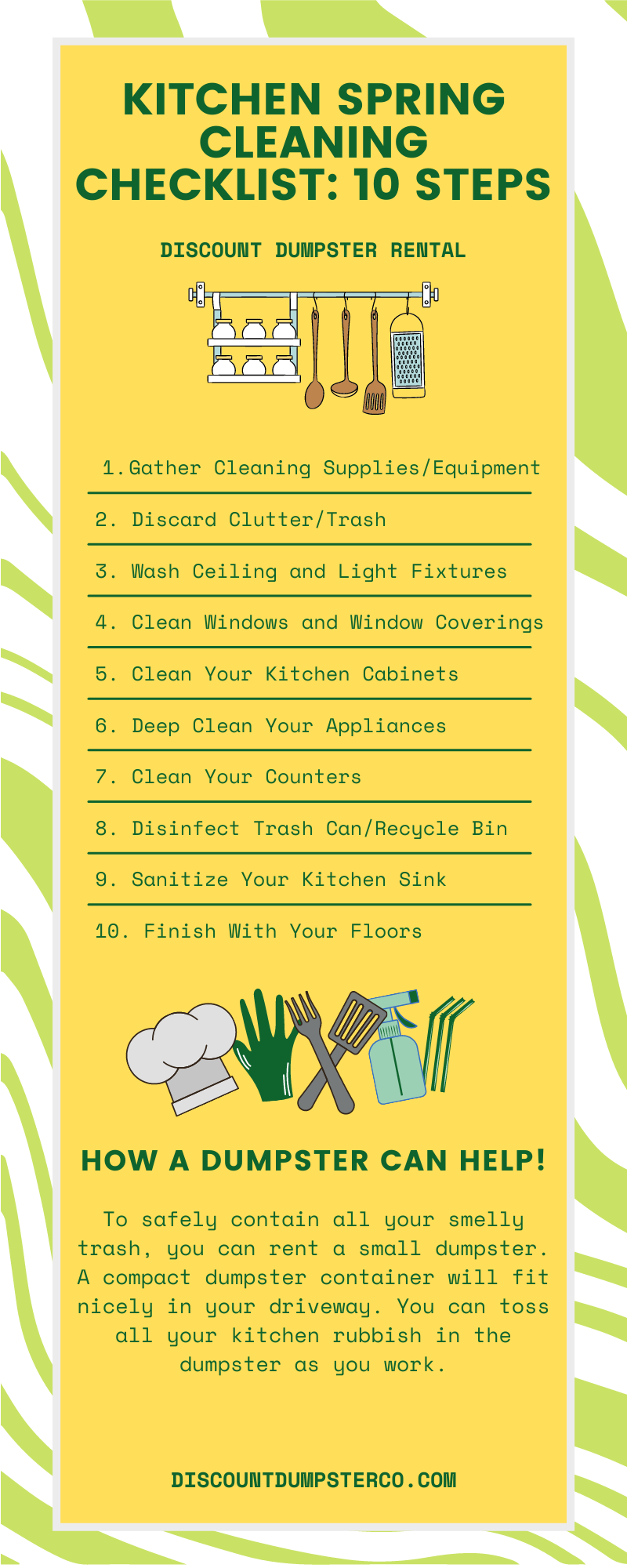Is your kitchen in need of a good cleaning, but you’re not sure where to start? You’re not alone.
Keeping this crucial space spotless can feel overwhelming. Yet, a clean kitchen is not just about aesthetics; it’s the heart of your home where health and happiness begin. Imagine walking into your kitchen and feeling a sense of peace, knowing everything is in its place and ready for your culinary creations.
This guide breaks down the cleaning process into simple steps, ensuring you can tackle it efficiently and effectively. Stick with us, and you’ll discover how easy it can be to maintain a kitchen that sparkles, inviting you to cook and create with joy. Ready to transform your kitchen into a clean and organized space? Let’s dive in!

Credit: thetripclip.com
Preparation
Cleaning the kitchen can feel overwhelming without proper preparation. Setting the stage makes the process smooth and efficient. Start with gathering cleaning supplies and decluttering countertops. These simple steps pave the way for a sparkling kitchen.
Gather Cleaning Supplies
Begin by collecting all necessary cleaning supplies. Grab a bucket, sponge, and microfiber cloths. Choose a multipurpose cleaner for surfaces. A dish soap and scrub brush are essential. Don’t forget gloves to protect your hands. Keep trash bags handy for waste disposal.
Declutter Countertops
Clear the countertops of unnecessary items. Remove small appliances temporarily. Put away food items and utensils. Gather all stray objects into a box. This makes cleaning surfaces easier and faster. Enjoy the extra space for efficient cleaning.
Cleaning Surfaces
Keeping kitchen surfaces clean is vital. It ensures hygiene and prevents germs. Clean surfaces also enhance the kitchen’s appearance. Let’s explore effective ways to clean different kitchen surfaces. From countertops to backsplashes, ensure every corner shines.
Wipe Down Countertops
Countertops are used daily. Start by removing all items. Use a damp cloth with mild soap. Wipe in circular motions. Focus on removing stains and spills. Rinse with clean water. Dry with a soft cloth. This prevents streaks and keeps the surface shiny.
Clean Cabinet Exteriors
Cabinet exteriors collect dust and grease. Use a gentle cleaner. Spray it on a soft cloth, not directly on the cabinets. Wipe from top to bottom. Pay attention to handles and edges. These areas often have more grime. Regular cleaning keeps them looking new.
Scrub Backsplashes
Backsplashes protect walls from spills. Yet, they need attention too. Use a non-abrasive cleaner. Apply it with a sponge. Scrub gently to avoid damage. Focus on grout lines. Rinse with water and dry well. A clean backsplash brightens the whole kitchen.
Appliance Care
Keeping kitchen appliances clean is vital. It ensures longevity and safety. Regular maintenance prevents issues. It also helps in achieving optimal performance. Each appliance demands specific care. Let’s explore how to maintain them.
Refrigerator Maintenance
Start by emptying the fridge. Remove expired or spoiled food. Wipe shelves with a damp cloth. Use mild detergent for stubborn stains. Clean the door seals. They often trap dirt. Vacuum the condenser coils. This improves efficiency. Check the temperature settings. Ensure they are correct. Organize the food neatly. This enhances airflow.
Oven And Stove Cleaning
Remove oven racks first. Soak them in soapy water. Use a gentle scrubber on them. Clean oven interiors with baking soda. It helps remove grease. Wipe down the stove surface. Pay attention to burners. Check for clogged gas openings. Use a toothpick to clean them. Ensure knobs are free of grime.
Microwave Freshening
Place a bowl of water inside. Add lemon slices. Heat for five minutes. The steam loosens grime. Wipe interiors with a cloth. Use dish soap for tough spots. Clean the exterior with a damp cloth. Ensure the vents are clear. Remove any debris. Check the turntable. Ensure it rotates smoothly. A fresh microwave enhances food taste.

Credit: discountdumpsterco.com
Sink And Faucet
Start with clearing the sink of any dishes or debris. Next, scrub the faucet with a mild cleaner to remove grime. Wipe the sink and faucet dry to prevent water spots.
The kitchen sink and faucet are vital for cleanliness. They help you wash and prepare food. Over time, they gather germs and dirt. Cleaning them regularly is essential. This ensures a healthy kitchen. Let’s explore how to clean them properly.Disinfect The Sink
Begin by removing any dishes. This clears the area for cleaning. Use a gentle scrubber and dish soap. Scrub the entire sink surface. Pay extra attention to corners and edges. Rinse thoroughly with warm water. For disinfection, mix vinegar and water. Spray the sink with this solution. Let it sit for five minutes. Wipe it clean with a cloth. This removes germs and odors.Polish The Faucet
Start by wiping the faucet with a damp cloth. This removes surface dirt. Use a mild cleaner for deeper cleaning. Apply it to a soft cloth. Gently rub the faucet until it shines. Pay attention to hard-to-reach spots. For extra shine, use a vinegar solution. This helps remove water spots. Buff the faucet with a dry cloth. Enjoy the sparkle!Floor Cleaning
Start with clearing the countertops and sink. Sweep the floor to remove crumbs and debris. Mop with a kitchen-friendly cleaner, focusing on sticky spots. Wipe down cabinets and appliances. Finish by cleaning the kitchen table and chairs. Ensure everything is dry before putting items back.
Cleaning the kitchen floor is an essential task that can transform the overall feel of your cooking space. A spotless floor not only looks great but also ensures a healthier environment for you and your family. Let’s dive into the steps that will make your kitchen floor sparkle, from sweeping to mopping and shining.Sweep Thoroughly
Start by removing any large debris or crumbs from the floor. Use a broom or a dustpan to gather up all the dirt. Pay special attention to corners and under cabinets where dust tends to accumulate. Consider using a soft-bristle broom for hardwood or tile floors to avoid scratches. Sweeping regularly prevents dirt build-up and makes mopping much easier. Have you ever noticed how much easier it is to mop a clean floor than a dusty one?Mop And Shine
Once the floor is free of debris, it’s time to mop. Choose a mop suitable for your floor type—microfiber mops work wonders on most surfaces. Use warm water and a mild floor cleaner for best results. Mopping not only removes grime but also gives your floor a fresh look. It’s satisfying to see the gleam after a good mop session. Finish by drying the floor with a clean towel or let it air dry. Adding a few drops of essential oil in the water can leave a pleasant aroma in your kitchen. Have you ever tried adding lavender oil? It smells amazing and keeps the kitchen inviting. Floor cleaning is more than just a chore; it’s a way to enhance your kitchen’s ambiance. When you feel the smooth surface under your feet, it’s a small reward for your effort.
Credit: www.apartmenttherapy.com
Trash Disposal
Trash disposal is a crucial step in cleaning the kitchen. Proper disposal helps maintain a clean and healthy environment. It prevents unpleasant odors and reduces the risk of pests. Follow these simple steps to ensure your kitchen remains spotless.
Empty The Bin
Start by emptying the trash bin. Take out the trash bag carefully. Tie it securely to prevent spills. Dispose of it in the designated outdoor trash area. This prevents bad smells from lingering in the kitchen.
Replace the old bag with a new one. Make sure it fits snugly in the bin. A proper fit helps contain any leaks or spills. This simple step keeps your kitchen clean and fresh.
Sanitize Trash Area
After emptying the bin, sanitize the trash area. Use a disinfectant spray or wipes. Clean the inside and outside of the bin. Focus on areas that come in contact with trash.
Pay attention to the surrounding floor space. Wipe the floor to remove any spills or stains. Regular sanitation prevents germs and bacteria from spreading. It ensures your kitchen remains a safe place to cook and dine.
Finishing Touches
After the hustle and bustle of cleaning the kitchen, you might feel relieved but there’s still one crucial step left: the finishing touches. These steps will elevate your kitchen from merely clean to truly inviting. It’s not just about tidiness; it’s about creating a space that feels refreshing and organized. Let’s dive into the details that will transform your kitchen into a haven.
Organize Kitchen Items
Start by assessing the placement of your kitchen items. Is your counter crowded with gadgets? Move less-used items to cabinets to free up space. Organizing your kitchen not only makes cooking easier but also gives a sense of calm. When you open a drawer and find everything neatly arranged, it feels like a small victory. Use drawer dividers and shelf organizers to keep everything in its place.
Think about the accessibility of frequently used items. Are your spices within reach? Can you easily grab the pot you need? Rearranging for convenience saves time and reduces frustration. Remember, a well-organized kitchen is a happy kitchen. How can you make your space work better for you?
Add Fresh Scents
A clean kitchen isn’t complete without a fresh aroma. Have you ever walked into a kitchen and been greeted by a pleasant scent? It’s like an invitation to enjoy the space. Consider natural options like lemon slices or mint leaves. You can boil them in water for a refreshing aroma.
Another simple trick is to use scented candles or essential oils. Choose scents that you love, like lavender or vanilla. These will not only freshen the air but also create a welcoming atmosphere. A kitchen that smells good feels good. What scent makes your kitchen feel like home?
Incorporating these finishing touches ensures your kitchen is more than just clean—it’s a place you love to be. Organize your items for efficiency and add a scent that makes you smile. What small changes can you make today for a big impact?
Frequently Asked Questions
How Often Should You Clean Your Kitchen?
Cleaning your kitchen should be a daily task. Wiping surfaces and doing dishes daily helps maintain hygiene. Deep cleaning tasks like scrubbing floors and cleaning appliances should be done weekly. Regular cleaning prevents bacteria build-up and keeps the kitchen fresh and functional.
What Are Essential Kitchen Cleaning Tools?
Essential kitchen cleaning tools include sponges, dishcloths, scrub brushes, and microfiber cloths. A good all-purpose cleaner and disinfectant are vital. Having a broom, mop, and vacuum also helps maintain cleanliness. These tools aid in efficiently tackling different surfaces and grime types.
How Do You Clean Kitchen Appliances?
To clean kitchen appliances, unplug them first. Use a damp cloth with mild detergent to wipe surfaces. For stubborn stains, use baking soda and water paste. Regular cleaning prevents dirt build-up and ensures appliances function well, extending their lifespan.
What’s The Best Way To Clean Kitchen Floors?
Start by sweeping or vacuuming kitchen floors to remove debris. Use a mop with warm water and mild detergent for deeper cleaning. For stubborn spots, a vinegar solution works well. Regular cleaning prevents grime accumulation and keeps the floor looking fresh.
Conclusion
Cleaning the kitchen can be simple and rewarding. Start with clearing the clutter. Wash dishes right after use. Wipe surfaces to remove spills and crumbs. Don’t forget to clean appliances. Sweep and mop the floor for a fresh finish. Regular cleaning keeps the kitchen inviting and safe.
It prevents germs from spreading. A clean kitchen makes cooking more enjoyable. Remember, small steps lead to big results. Follow these steps and keep your kitchen sparkling. Enjoy the process and the results. Your kitchen deserves the best care.

As the chief content writer, Hassan Al Sarker works as a professional kitchen-based content creator at Kitchen Liker.
In addition to reviewing the content published on Kitchen Liker, he ensures that it is accurate, relevant, and helpful. As a result, all the reviews and information published at Kitchen Liker are neutral and userfriendly.
Hassan Al Sarker has a bachelor’s degree in Hotel and Tourism Management From the Newyork University. Before joining Kitchen Liker, he was a contributor at Kitchen Club, United States.
